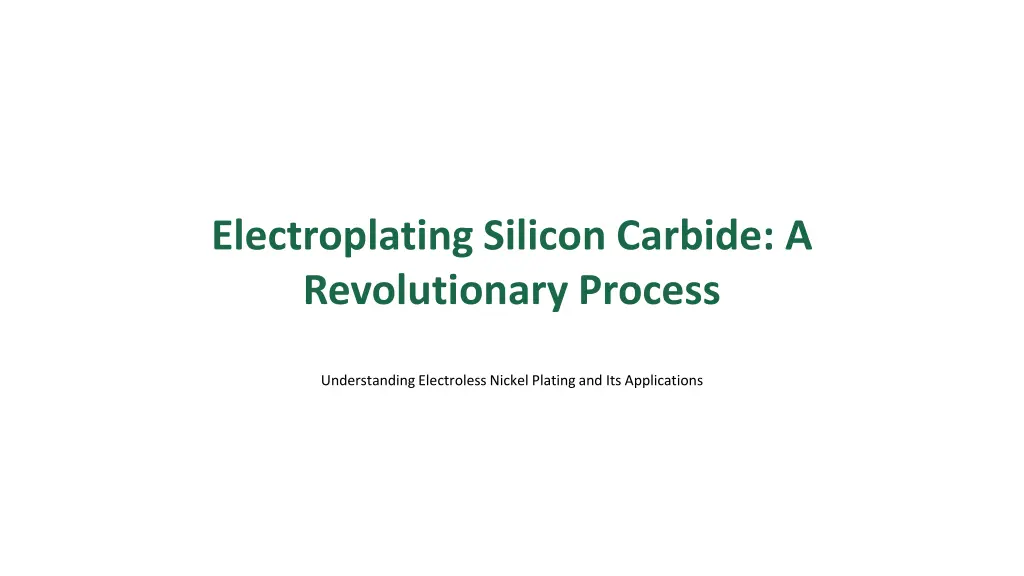
Silicon Carbide Electroplating: A Revolutionary Process
Discover the groundbreaking process of electroplating silicon carbide and the applications of electroless nickel plating. Uncover the benefits, chemical reactions involved, temperature's role, and future trends in this innovative technique. Explore how electroplating enhances durability, performance, and sustainability in various industries.
Download Presentation

Please find below an Image/Link to download the presentation.
The content on the website is provided AS IS for your information and personal use only. It may not be sold, licensed, or shared on other websites without obtaining consent from the author. If you encounter any issues during the download, it is possible that the publisher has removed the file from their server.
You are allowed to download the files provided on this website for personal or commercial use, subject to the condition that they are used lawfully. All files are the property of their respective owners.
The content on the website is provided AS IS for your information and personal use only. It may not be sold, licensed, or shared on other websites without obtaining consent from the author.
E N D
Presentation Transcript
Electroplating Silicon Carbide: A Revolutionary Process Understanding Electroless Nickel Plating and Its Applications
01 What is Electroplating? Table of Contents 02 Introduction to Silicon Carbide 03 The Electroless Process 04 Chemical Reactions Involved 05 Temperature s Role in the Process 06 Benefits of Electroless Nickel on Silicon Carbide 07 Applications in Industry 08 Environmental Impact and Sustainability 09 Future Trends in Electroplating 10 Thank You!
1 What is Electroplating? Electroplating is a process that uses electrical current to reduce dissolved metal cations so that they form a coherent metal coating on an electrode. This technique improves the properties of substrates, providing aesthetics, corrosion resistance, and wear protection. It's widely used in industries ranging from automotive to electronics, enhancing product longevity and performance. Electroplating is also important in jewelry making and manufacturing, showcasing its versatility across various applications. Understanding its fundamentals sets the stage for exploring Silicon Carbide's unique benefits.
2 Introduction to Silicon Carbide Silicon Carbide (SiC) is a compound of silicon and carbon, renowned for its hardness and thermal conductivity. Due to these properties, SiC is becoming a material of choice in electronic devices and high-temperature applications. Its use in electroplating offers enhanced durability and performance, making it ideal for demanding environments. SiC coatings can significantly reduce wear and tear, thus prolonging the life of components. This makes the understanding of its electroplatingprocess essential for various industries.
3 The Electroless Process Electroless plating is a chemical process where a metal is deposited onto a substrate without the use of external power. The reaction relies on the interaction between nickel, phosphorus, and the substrate material. This method allows for uniform coating, even on complex geometries, and ensures excellent adhesion. The results often surpass traditional electroplating in terms of quality and consistency. This technique is pivotal in delivering high-performance coatings on silicon carbide.
4 Chemical Reactions Involved At the heart of the electroless process is a complex chemical reaction between the metal ions and reducing agents. Nickel ions are reduced to nickel metal while phosphorus bonds with the substrate. This reaction occurs in a high-temperature bath, facilitating rapid deposition of nickel on the surface. Understanding these reactions helps in optimizing the process for various coatings. The right balance of temperature and chemistry is crucial for successful outcomes.
5 Temperature s Role in the Process Temperature significantly impacts the rate and quality of the deposition in electroless plating. Higher temperatures generallyincrease reaction rates, leading to faster plating. However, maintaining the right temperatureis critical; overheatingcan degrade the coating's properties. Optimal conditions ensure a uniform and robust layer of nickel on silicon carbide. This can be tailored according to specific application requirements.
6 Benefits of Electroless Nickel on Silicon Carbide Coating silicon carbide with electroless nickel offers numerous advantages, including enhanced wear resistance. The process provides a smooth and even coating that can endure harsh environments. Electroless nickel also improves corrosion resistance, making components less susceptible to degradation. These benefits are crucial for industries such as aerospace, automotive, and electronics. Applications with high durabilityrequirements find electroless nickel coatings invaluable.
7 Applications in Industry Electroless nickel plating on silicon carbide is widely applied in electronics, automotive, and defense sectors. In electronics, it enhances components by providingincreased conductivity and reliability. In automotive applications, it improves engine components, prolonging their life and efficiency. Moreover, defense applications require high-performance materials, making SiC coatings essential. The versatility of this technology opens new avenues for innovation in various fields.
8 Environmental Impact and Sustainability The electroless nickel plating process can be more environmentally friendlycompared to traditionalmethods. It often produces less waste and avoids the discharge of harmful substances into the environment. Employing sustainable practices in electroplating supports corporate responsibility and regulatory compliance. By choosing the right processes, industries can contribute to a healthierplanet. Sustainability is becoming increasingly importantin modern manufacturing.
9 Future Trends in Electroplating The future of electroplating, especially with silicon carbide, lies in advancements in technology and materials science. Innovations may lead to more efficient processes, reducing costs and improving quality. Emerging applications such as electric vehicles and renewable energy will drive demand for advanced coatings. Developments in nanotechnology could enhance the properties of existing coatings. The field is poised for exciting transformations as industries evolve.
10 Thank You! Thank you for exploring the fascinating world of electroplating silicon carbide with us! We hope this presentation has enlightenedyou about the benefits and processes involved. Your engagement is invaluable in fostering a deeper understanding of this technology. We encourage furtherexploration and discussion on this innovative process. Feel free to reach out for any questions or collaborations.
